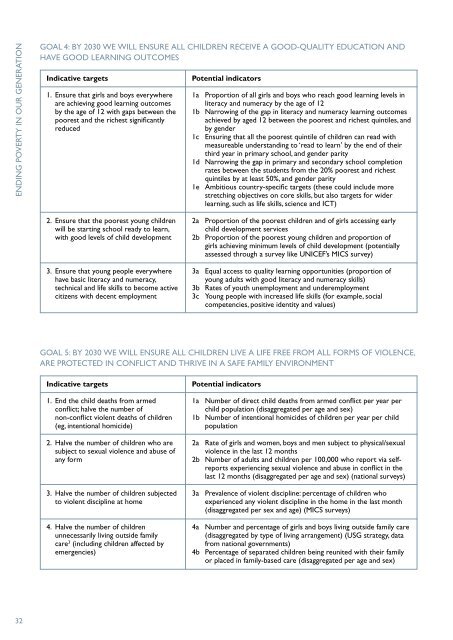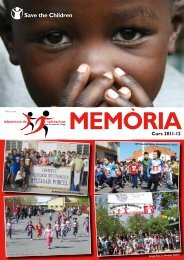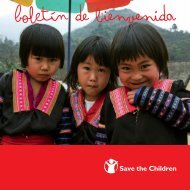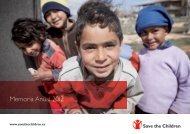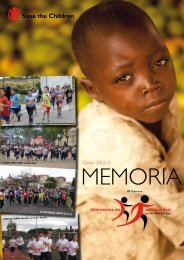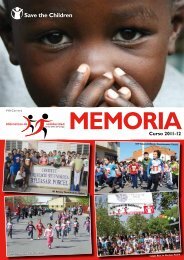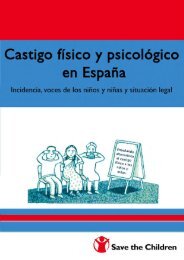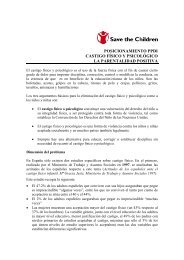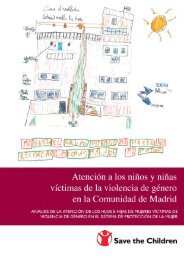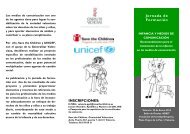ENDING poverty - Save the Children
ENDING poverty - Save the Children
ENDING poverty - Save the Children
You also want an ePaper? Increase the reach of your titles
YUMPU automatically turns print PDFs into web optimized ePapers that Google loves.
<strong>ENDING</strong> POVERTY IN OUR GENERATION<br />
GOAL 4: BY 2030 WE WILL ENSURE ALL CHILDREN RECEIVE A GOOD-QUALITY EDUCATION AND<br />
HAVE GOOD LEARNING OUTCOMES<br />
Indicative targets<br />
1. Ensure that girls and boys everywhere<br />
are achieving good learning outcomes<br />
by <strong>the</strong> age of 12 with gaps between <strong>the</strong><br />
poorest and <strong>the</strong> richest significantly<br />
reduced<br />
Potential indicators<br />
1a Proportion of all girls and boys who reach good learning levels in<br />
literacy and numeracy by <strong>the</strong> age of 12<br />
1b Narrowing of <strong>the</strong> gap in literacy and numeracy learning outcomes<br />
achieved by aged 12 between <strong>the</strong> poorest and richest quintiles, and<br />
by gender<br />
1c Ensuring that all <strong>the</strong> poorest quintile of children can read with<br />
measureable understanding to ‘read to learn’ by <strong>the</strong> end of <strong>the</strong>ir<br />
third year in primary school, and gender parity<br />
1d Narrowing <strong>the</strong> gap in primary and secondary school completion<br />
rates between <strong>the</strong> students from <strong>the</strong> 20% poorest and richest<br />
quintiles by at least 50%, and gender parity<br />
1e Ambitious country-specific targets (<strong>the</strong>se could include more<br />
stretching objectives on core skills, but also targets for wider<br />
learning, such as life skills, science and ICT)<br />
2. Ensure that <strong>the</strong> poorest young children<br />
will be starting school ready to learn,<br />
with good levels of child development<br />
3. Ensure that young people everywhere<br />
have basic literacy and numeracy,<br />
technical and life skills to become active<br />
<br />
2a Proportion of <strong>the</strong> poorest children and of girls accessing early<br />
child development services<br />
2b Proportion of <strong>the</strong> poorest young children and proportion of<br />
girls achieving minimum levels of child development (potentially<br />
assessed through a survey like UNICEF’s MICS survey)<br />
3a Equal access to quality learning opportunities (proportion of<br />
young adults with good literacy and numeracy skills)<br />
3b Rates of youth unemployment and underemployment<br />
3c Young people with increased life skills (for example, social<br />
competencies, positive identity and values)<br />
GOAL 5: BY 2030 WE WILL ENSURE ALL CHILDREN LIVE A LIFE FREE FROM ALL FORMS OF VIOLENCE,<br />
ARE PROTECTED IN CONFLICT AND THRIVE IN A SAFE FAMILY ENVIRONMENT<br />
Indicative targets<br />
1. End <strong>the</strong> child deaths from armed<br />
conflict; halve <strong>the</strong> number of<br />
non-conflict violent deaths of children<br />
(eg, intentional homicide)<br />
2. Halve <strong>the</strong> number of children who are<br />
subject to sexual violence and abuse of<br />
any form<br />
3. Halve <strong>the</strong> number of children subjected<br />
to violent discipline at home<br />
4. Halve <strong>the</strong> number of children<br />
unnecessarily living outside family<br />
care 3 (including children affected by<br />
emergencies)<br />
Potential indicators<br />
1a Number of direct child deaths from armed conflict per year per<br />
child population (disaggregated per age and sex)<br />
1b Number of intentional homicides of children per year per child<br />
population<br />
2a Rate of girls and women, boys and men subject to physical/sexual<br />
violence in <strong>the</strong> last 12 months<br />
2b Number of adults and children per 100,000 who report via selfreports<br />
experiencing sexual violence and abuse in conflict in <strong>the</strong><br />
last 12 months (disaggregated per age and sex) (national surveys)<br />
3a Prevalence of violent discipline: percentage of children who<br />
experienced any violent discipline in <strong>the</strong> home in <strong>the</strong> last month<br />
(disaggregated per sex and age) (MICS surveys)<br />
4a Number and percentage of girls and boys living outside family care<br />
(disaggregated by type of living arrangement) (USG strategy, data<br />
from national governments)<br />
4b Percentage of separated children being reunited with <strong>the</strong>ir family<br />
or placed in family-based care (disaggregated per age and sex)<br />
32


